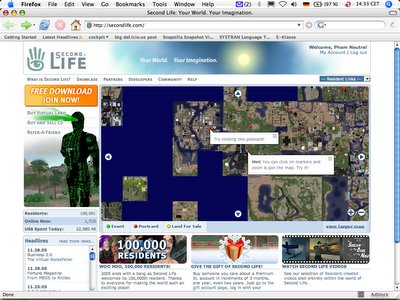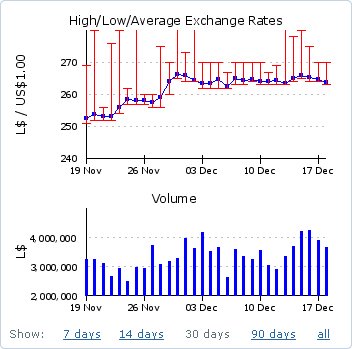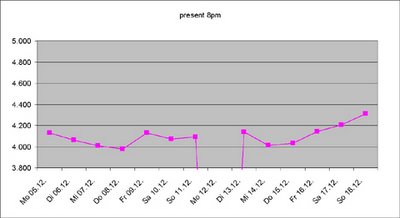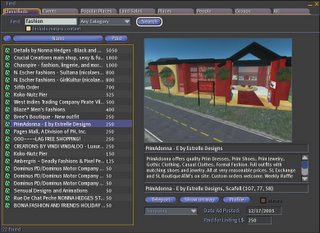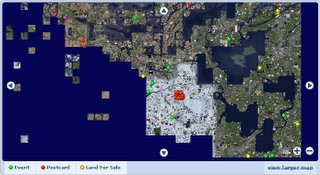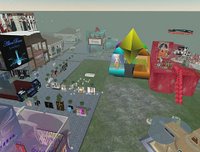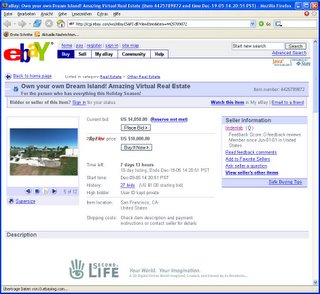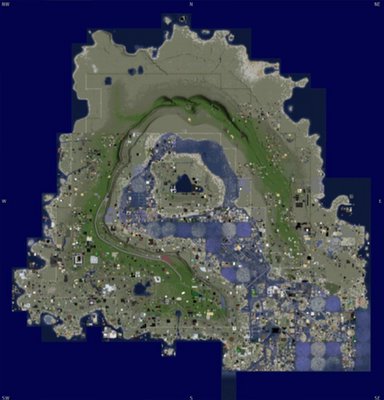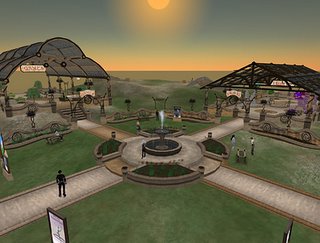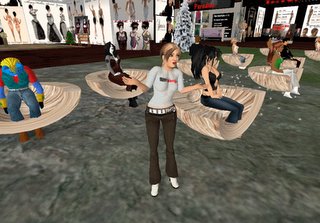Time flies - at least when you have reached a certain age and the timespan between Thanksgiving and Christmas does not feel like an eternity anymore. In SL time flies even faster; by a factor of four at least I would say. In a single month a lot can - and will - happen in here.
The last month was a very "interesting" one for the SL economy - the aspect of Second Life which fascinates me most. And I would like to "look back" on it a little; not in anger but in awe. Here is my - completely subjective - list of most interesting events and developments:
- The Aftermath of 1.7
- Anshe's Crusade against Ginko
- Lindens entering the "Zoned Residential Business"
- The Killing of the Telehubs
- The Rise (or Fall) of the Linden
- The Invention of the Camping Chair
But first ... the raw numbers:
Cold factsIn the last month the official population of Second Life grew from some 20% from 75,000 accounts (I am very intentionally not speaking of "residents") to more than 90,000. In the same time the average number of concurrent users inworld grew some 15%. The second number is much harder to measure as it varies greatly over the day and over the course of a week. I am using a procedure of taking a measurement every day at 8pm and I guess generates comparable numbers for statistical purposes.

The number of concurrent users inworld grows fast but not as fast as the number of residents; sometimes the growth even comes to a grinding halt (see the time between the 12th and the 24th)
Whats to interesting with these numbers? Simple: The difference between those two growth rates surely signals an ongoing change in the population.
Second Life grows; fast! And at the same time the structure of the population changes. The trend is towards more residents that spend less time in SL; less intense user, more casual ones (and probably a much lower percentage of premium accounts).
The LindeX clearly is establishing itself as the premier curency exchange and is accepted more and more by the residents. The average daily trade volume grew from something around 2 Mio. L$ to now more than 3 Mio. L$ per day. Thats roughly 11,000 to 12,000 US$ per day at current exchange rates. Not really "BIG MONEY" but still ... nearly 90 Mio. L$ (350,000 US$) in the month. And the trend is "up".
There is no detailed data available for the SL economy.
Current statistics have not been published since October, which is a pity. Many important facts about the SL economy seem to be generated by manual processes.
And now back to the "events" mentioned:
The Aftermath of 1.7Its now more than one month after the update to 1.7. And still threads like "I want to go back to 1.6" get updated. I am not sure if this is "normal" for a "first digit update", as I have been in SL only for a year now. Personally I found the first days and weeks after the 1.7 release to be the hardest time I have had in SL so far. And it worries me a little that - maybe purely subjective - the user experience in SL seems to be still worse than in 1.6 one month after the update. Some details surely are improved. Some of the first HUD applications are nice. Load balancing on the servers is much better and it is not a big problem now to have a wedding with some 60 or 80 people in a fast sim. Nice, too! On the other hand texture problems are still annoying, the new default textures are giving the surrounding a surreal geometric look when you teleport into a new region and the local cache seems to have become utterly useless.
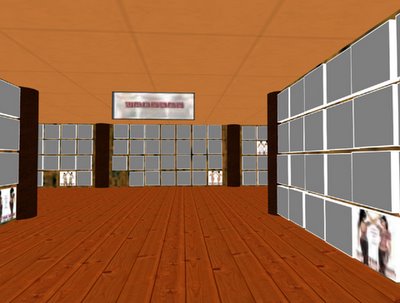 Happy shopping in the gray goo
Happy shopping in the gray gooWhy do I mention this in a post on the SL economy? Because business surely has taken a hard hit. Shopping was not much fun for many in the first weeks of November. And browsing malls even now is sometimes more "work" than fun. You have to very patient sometimes till you see the product pictures. Aditionally I am not sure what impression newbies got, when they rezzed in the Welcome Area for the first time in those first weeks of 1.7. While I applaud the continued development of the platform Second Life, I dare to say that the poor quality control that was visible in this update surely was not very "business friendly".
Anshe's Crusade against Ginko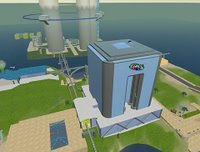
Anshe was not the first resident suggesting that the interest rates Ginko is promising for deposits are only possible in a so-called "Ponzi Scheme", an elaborate systenm of investment fraud, that is more or less a Snow Ball model dependant on a continously growing number of members. (More at the Wikipedia here.) But she surely was the most prominent - and vehement - proponent of that theory. No one can say for sure if Ginko is a Ponzi Scheme. I am unsure myself. But I am sure no one will get me to "invest" my money at an institution with no independent oversight and a complete unwilllingness to disclose any details about investments or even investment strategy ...
Additionally, the Ginko affair shines a bright light on one of the gaping holes in the current SL economy: there are no Banks! (To call Ginko a "bank" would be a gross misunderstanding of the workings of a bank in the RL economy.) Banking would be a very helpful addition to the SL society. Like in RL their most important function job would be "Savings and Loans": collect money that is not immediately needed and lend it to others who like to fuel their businesses with some cash. Sadly this is not easy to implement in SL. Banking is based on trust and legal recourse. And trust is a rare currency in SL - with so many possibilities for fraud and no institution willing to provide the needed oversight and protection of small customers.
The problem vice versa (for any potential bank business) is the complete lack of ways to collect debts and to protect themselves from residents simply leaving SL. That problem could possibly be solved with mortgaging land and some better group management tools, though (with banks and customers in the same group). Maybe a promising idea for some entrepreneurial spirits? (If someone is already doing something like this in SL, I beg for forgiveness. I did not know.)
But all in all I guess the whole Ginko affair did not further the willingness of the average resident to give money to someone they know nothing about. But I am sure that some kind of true banking will come to SL in the course of 2006.
The Killing of the TelehubsWhile the "Crusade against Ginko" maybe only a storm in a waterglass (a.k.a. SL forums) another development immediately showed significant consequences - and will have far reaching consequences over the next months. The Killing of the Telehubs annnounced on the 23rd not only lead to nearly
violent controversies on the SL forums. It significantly devalued the land holdings of many residents (not only land barons) and lead to the recent dramatic drop of the L$s value. One might argue the last point. It is hard to see only accidental coincidence in the fact that this drop started on the same day and up until now led to a drop of 7%, though.
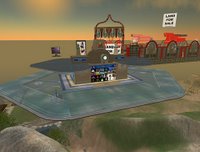
One possible way to see this, is, that in the long run the value of land only will be distributed, with telehub land falling in value and land far away from hubs rising (because it is easier accessible now). For all those landlords heavily invested in telehub land this is a small consolation. Some serious money already has been lost here. I am just waiting for some to start more or less desperately liquidating their assets. (Not Anshe; she is very well diversified.)
But there are some who specialized in telehub land, which - in hindsight - might have been a very risky strategy; especially, when taking into account that the lobbying for P2P teleportation has been going on in the forums for quite a while and the official reaction on the Linden side was never to oppose this clearly.

The publicly-stated consideration of some kind of compensation for owners of telehub land adds another twist. While such thoughts surely are not without merit - government intervention in RL often leads to similar compensation programs - they set an interesting precedent. Nearly every change in SL is bad for some business owners (and maybe benefitial for others). Will every significant feature change lead to a rally for compensatory measures from now on?
The Rise (or Fall) of the Linden
As I already mentioned, in the last two weeks of November, the Lindens value dropped some 7% from 251 L$/US$ to 266 L$/US$. While this drop might not seem overly concerning to many residents - maybe even advantagous ("Woot! I get more Lindens for my Dollar at LindeX!") - for low-margin businesses on the edge of RL and SL this is rather dramatic. In the land business this can easily eat up most of the profit for a sim auctioned based on the assumption of an exchange rate of 250 - 255 and now sold in the era of an exchange rate around 270. That is true at least for land that is bought at the auctions, because winning bids have to be paid in US$. It is true also for all those using their SL business as a significant part of their RL income. The margin question is not so dramatic here but their counter measures will be the same.
While some will rejoice at this thought ("Finally those greedy capitalists will get what they deserve!") there is not much reason for joy even for Joe Averageresident. The land barons simply will raise land prices! And other content producers will follow ... There is a name for that phenomenom: its called "inflation" and is no fun at all. But maybe its all not as dramatic as it seems now. It all depends on the length of the drop. There is no fundamental reason for the Linden losing value like this; just selling pressure and psychology. And maybe some business people realized just how risky business in the SL economy can be; with real "gods" that can change the basic laws of the universe ...
And this is at least one reason why "Economy in SL" continues to be as entertaining as any soap opera.
But. oops, I forgot. This can't be the end. (Yes, I know, it
is a long post already.) There is still one issue: Camping chairs.
The Invention of the Camping ChairBut as fascinating as this concept is, it has been discussed more than thouroughly on the forums already. And
Ingrid and
Flipper already have written in this weblog about them at some length. When you read the SL forums nobody seems to like them very much. Still they have taken the world by storm.
Personally I don't like them much, but thats ... personal. What I find fascinating with camping chairs and their derivatives is how good an example they are for the inherent cleverness of an economic system. Because Camping chairs are a perfectly logical solution for making money in SL; a solution that is a true win-win situation for nearly everyone involved. Their invention was inevitabable!
Its as simple as that: a growing number of residents is looking for an easy way to make money. They are not much qualified in the skills that in the past were most important for making money in SL (designing, building, scripting, dealing ...). So a job is needed that can be done without any of this qualifications. And what those residents do is better something that is of immediate value/results in a fast return. Otherwise giving those newbies a job does not make much sense for the "employer".
In the past the typical jobs in this category were dancer, host etc., jobs where the intent was to attract other residents to a club. Having them at the club is interesting in two ways for the owner: 1) the residents attracted might buy something in the nearby shopping malls or employ the services of an escort in the clubs pay. 2) At the same time their presence generates "dwell", which the Lindens reward with bonuses and developer incentives. The first aspect has some disadvantages: you never know if customers actually buy something. And in addition they have to have money for that, which is a problem with newbies on basic account.
Generating dwell costs the customer/employee nothing! And thats why
camping chairs are a much better and perfectly logical solution which is beneficial to both, employer and employee.
I am no specialist for dwell calculation. So I am unable to judge how succesful the idea can be in the long run. For example: what is an hourly rate you can pay a professionall "sitter" and still make a profit - in a calculation model which is changed daily right because of the advent of the camping chair? Many a club that based its payouts on last months dwell calculation might be making a loss fast. But anyway: I will risk the prediction that we won't see them for long. The intention Linden Lab had with the introduction of the dwell bonus (motivating residents to produce interesting content which attracts other residents - and keeps them in SL), is perverted by camping chairs. While camping chairs - or any comparable business model - in itself might do not much harm. A very unwelcome side effect is, that they reduce the motivation for other residents to produce other kinds of interesting content. Next months developer incentives will be paid in a large part to clubs with dwell chair.
Dwell - and the exploitation of this incentive by camping chairs - is a good example for the
big problems with any kind of subsidy. After a short time clever businesses will allways find some holes in the rules for the payout of this subsidy. And then they will "milk" the state (in this case Linden Lab) with some business model which is far away from the intent that subsidy had, when it was introduced. There are enough RL examples for that. Now we have a nice one in SL.
So sooner or later - despite denials from Robin - we will see a change in the rules for bonus calculation. Some clubs will have to change their business models rather fast then - but maybe they will get an nice compensation for it.
 I have visited the new landmass this morning and can testify that it is beautiful. It is landscaped in a very different style from the Northern Continent. Not so much a tropical or subtropical land but more of a north European (or - more likely - north American) style; even though it is far in the south of the map. Just now it is virgin country, untouched by building activities, a joy to explore and a welcome addition to SL after a time where nearly all the new mainland was styled according to the subtropical theme. It is very desirable land and I wonder what will happen when these sims appear on the auction block.
I have visited the new landmass this morning and can testify that it is beautiful. It is landscaped in a very different style from the Northern Continent. Not so much a tropical or subtropical land but more of a north European (or - more likely - north American) style; even though it is far in the south of the map. Just now it is virgin country, untouched by building activities, a joy to explore and a welcome addition to SL after a time where nearly all the new mainland was styled according to the subtropical theme. It is very desirable land and I wonder what will happen when these sims appear on the auction block. The new landmass is comparably small and very far in the south. (the little spot in the bottom right of the map). One may wonder if this was to "hide" it or if it will be used for a special project. The fact that one sim on it already has been opened for the Land for the Landless program indicates that this will not be the case though.
The new landmass is comparably small and very far in the south. (the little spot in the bottom right of the map). One may wonder if this was to "hide" it or if it will be used for a special project. The fact that one sim on it already has been opened for the Land for the Landless program indicates that this will not be the case though.